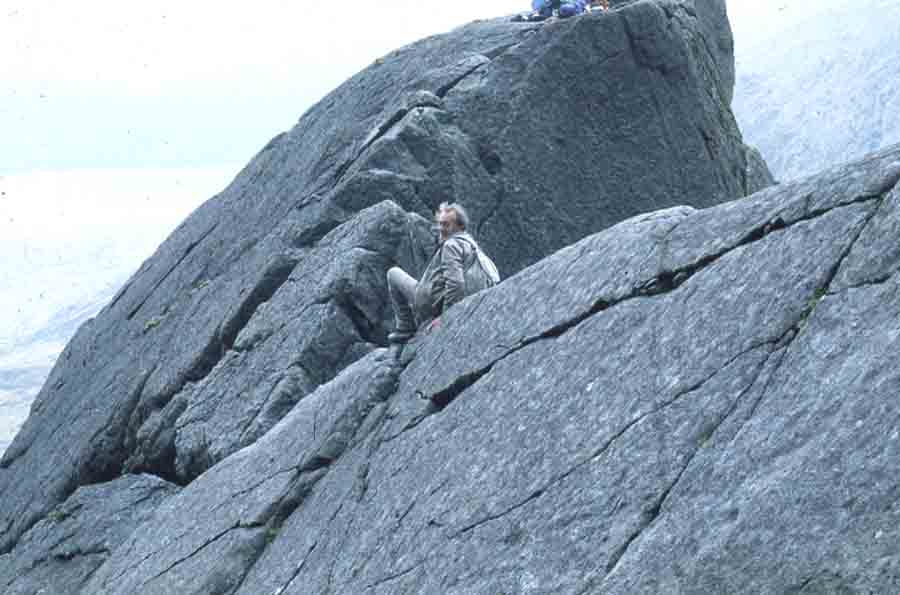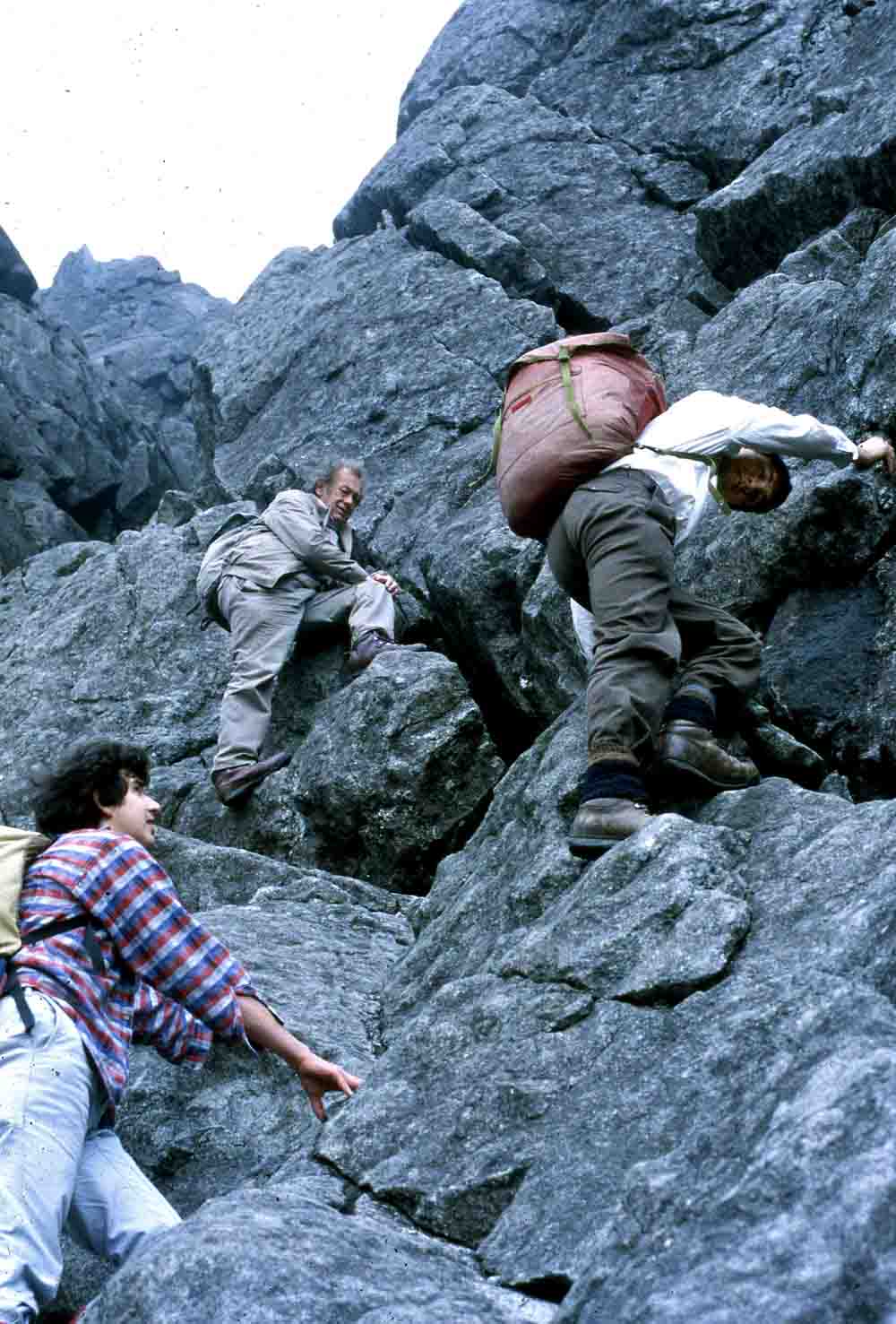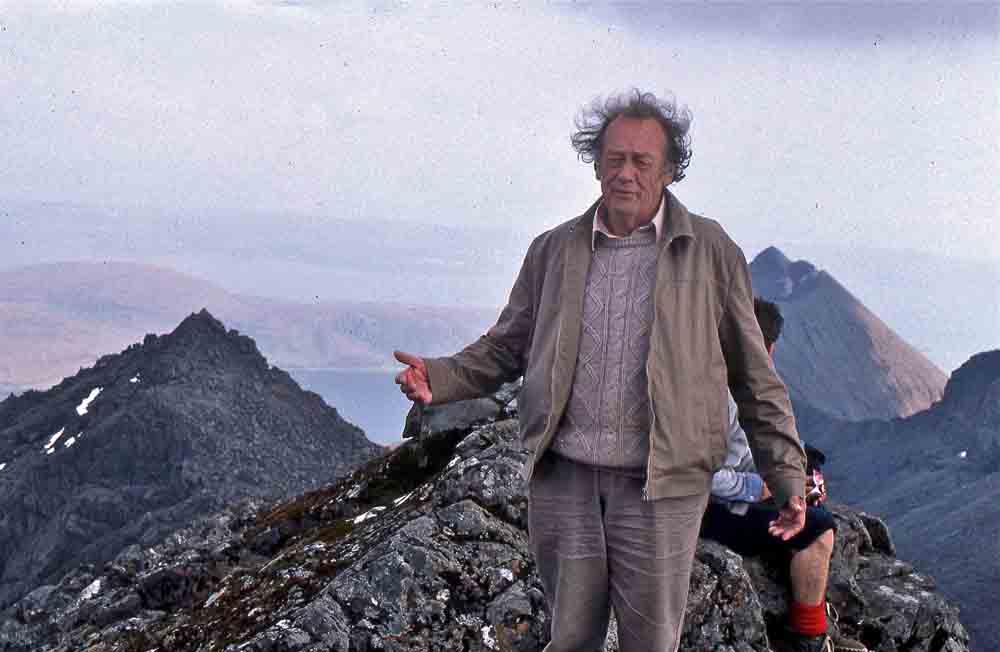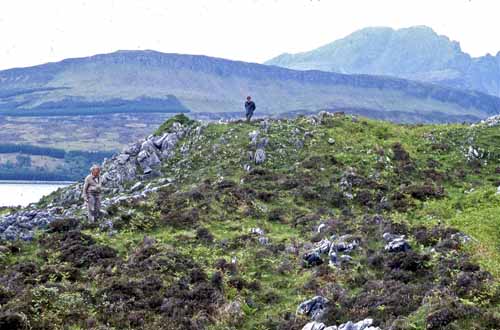Anecdotes
The pages below are under development and will be updated on a regular basis.
Click on pictures for larger view: use back arrow for return
Down in the Glen
A stately personage of considerable antiquity disembarks from the Greater Warrenmobile. He wears a cloth cap fashioned, one might imagine, from a dehydrated cow-clap. He is closely followed by youthful pair of mathematical physicists. The fourth member of this quaint assemblage leaps out. He rapidly assesses the area of the car park, estimates the elevation of the heights to be scaled, examines the apparel of the assembled party and persuades the elder member that Wellington Boots are quite inadequate for the eminences and precipices to be encountered during the ensuing day, The younger members of the party leap and bound goat-like across the dry moorland, bog and moss alike. They fall into the shadow of the intimidating black cleft of Eastern Gully. The patriarchal figure follows at his own pace. He has donned an old ganzy for protection against the fearsome cleg and he is now leather-shod. A misleading pace too is that of the elder member as he moves nimbly over the coarse gabbroic boulders. In a short time the quartet assembles at the base of the polished inclined slabs of Sron na Ciche. They are now under the Cioch, “The Pap" of the Victorian Era. Two of the team are familiar with the ground. Two face the unknown. Ahead lie treacherous moves over jagged rocks and along narrow ledges. All the while they are exposed to the wide green glen many hundreds of feet below. An untoward slip will bring Madame Fate leaping forward to take the unfortunate being into her cold unwelcome arms. All misgivings about the competence of the team are shed ere the arete leading to the Cioch itself is attained.

Roy Thorley on the approach to the Cioch. Photo SEW May 1990


It's a bit hairy in parts but the ascent of Sgurr a Thearlaich presents no insuperable difficulties to our intrepid quartet. Shawn Kelly, Roy Thorley and Patrick Warren on the way up.
"Get me out of here. I'm clifted" Roy on top of Sgurr a Thearlaich.
The three tyros valiantly mount the horse's back to gallop across to the great rocky breast of the Maid of Brittle. The Patriarch holds back. Such desecration is not for him. The Flower of the CuiIIin is not to be found in his Flora and thus need not be gathered. Turning aside, he casts a cynical eye over the vertiginous crag. There, low down and to the left, lies an untrodden green carpet, no more than a handspan, or a boot-width. Nearer and higher there's a horizontal crack, no more than a scratch. Nonetheless, for the surefooted, it is an avenue undefiled by the cragsman's nails. "Thorley's Route" is to be engraved in the annals of climbing history, by the darker Mathematician first and then by the fairer Physicist and the Surveyor. Satisfied, sated indeed, the venturers turn to the next challenge. They are to ascend the upper reaches of Eastern GulIy, Sron na Ciche and Alasdair. They are to overlook the gloomy black waters of Loch Colr a Ghrunnda. Along the way the dark mouth of the "Cave" gapes open and laughs. It is laughed at. These are no timid daylight climbers but true mountaineers of darkness.
They have been reared In the black chasms of the Yorkshire underworld. With a thrutch and a squeeze the obstacle is passed and so is the next obstacle if it could be so named, the infamous "Mauvais Pas", the "Bad Step" of ill repute. For the aspiring scrambler the ascent of Sgurr Thearlaich ranks amongst the most difficult in the CuiIIin. The descent is positively perilous. Our cloth capped climber heeds not the forebodings of his conscience. He scales the basaltic bastion with consummate ease. He savours the sweetness of superiority amongst the highest of the CuiIIin peaks. After a brief moment of triumph he is in an embarrassing position: 'clifted' in effect. Not. for the first time in his life he spurns the offer of a rope, opting instead for the true gentleman's solution, a paid guide. The offer of a shilling, a genuine piece of silver, quickly brings the required response. Inch by Inch, step by step, they descend to the Bealach of Sgurr Alasdalr. Foot by foot, stone by stone, they descend the Great Stone Shoot. Yard by yard, mile by mile, they stride across the moors down the glen to celebrate the day's events in traditional style at the bar of the nearest hostelry.
Down in the Boathouse
On Thursday, the Builder rouses all at the crack of dawn with morning tea and a beaming face; if the tea is anything to go by we are in for a big day. "I've made porridge for everybody today. Come and get it.". The porridge is of a consistency such that only The Builder has the physical strength to stir the three full buckets already prepared. After Pixie nearly breaks her wrist trying to dig some out of her dish it is decided to find a better use for it, and what better than to level the floor of the common room. The bunkhouse is fine, a converted boathouse we are told. The Irish connection is revealed in the origins of the 'common' room which has a distinct and sometimes disturbing slope to the floor. The building is some four hundred yards from the shore to boot.
By good fortune the first night at Portnalong coincides with the local 'party night' at the bar, a fund raising event of great interest and amusement.Did they see us coming? Perchance the luck of the draw, for an extremely large and perfectly fresh salmon, falls to one who is neither in need of such a prize nor wants it. An auction is quickly arranged whereby the auctioneer takes bids seemingly from the visitors only with, believe it or not, The Eagle, The Inspector and The Surveyor bidding against each other. At £15 shared between thirteen it is a small price to pay for the ensuing hospitality and friendliness. Nothing like getting in with the locals, one might say.

On another day, the two Mathematicians, Tweed Jacket and The Surveyor wind their way round to the sublimely beautiful Bay of Camas Malag. Over the iridescent waters of Loch Slapin and the Sea of the Hebrides lie the enchanting small Isles, Rhum, Elgg, Muck and Canna. Nearer to hand stands the bulk of Bheinn an Dhuaidh. Over-towering the scene rises the massive rampart of Clach Glas and Its buttressing masses of Belig, Blabheinn and Garbheinn: to this fortress siege will be laid on another day. Underfoot the limestone pavement nourishes a green sward bearing a rare flora perused with the enthusiasm of the converted. Thence to Talisker Bay In pursuit of, not the magic fluid, but the magic crystals.
" a rare flora" mountain avens near Torrin
Photo SEW May 1990
Mud in my hair
On a warm sunny afternoon, sometime in the early 1980s, we were strolling down Clapdale, Edward and myself, after a long day prospecting for caves, pots, shakeholes, digs, in fact anything that might reveal a new cave passage. A few feet of something new would have done; a hundred yards would be better; as for "caverns measureless to man"! Well: that was our dream, along with that of a handful of other like-minded cavers who pounded the fells of this enchanting Three Peaks country. Perhaps 'prospecting' was an ambitious term, more like grovelling, scratching and scraping in any shakehole that had an attraction for us. Perhaps 'strolling" is a misleading term too, weighed down as we were with back-packs stuffed with hammers and chisels, spades, ropes and a variety of bars including the infamous 'ali-bar-bar". Then there was our caving gear, thick and heavy with the day's accumulation of damp mud and clay. We had spent the day scratching around in Body Pot and several other likely or unlikely holes around Clapham Bottoms, and our final session had been in Owl Hole. This rather unpleasant hole is well hidden off the beaten track somewhere behind the more prominent Foxholes. noted for Neolithic remains found by archaeologists of an earlier era. Owl Hole was described in Northern Caves, Vol 3, as, "Roomy passage descends and lowers to pool and clay choke". After an most unproductive day, we saw this 'roomy passage' as a large phreatic tube choked from floor to ceiling with thick sticky glacial mud.
The nearest known passages were in the Far Country series of the Gaping Gill system, some considerable distance away, and, a great depth below our feet were the water logged passages of the further reaches of Ingleborough Cave. All we had to do was dig away at this clay until the way was open. A few minor obstacles such as a thick barrier of brambles and nettles, sticky mud, and various animal bones, had to be overcome, before we could tackle the clay choke. The Gaping Gill district is renowned for dense tough clay deposits and this was no exception. An hour or so scraping away hardly made an impression on the barrier and left us totally plastered with thick yellow clay. We gave it up as a bad job, at least for the time being, cleaned up as best we could and set off for Clapham. As we walked by the entrance to Ingleborough Cave where the last of the day's visitors were leaving, I felt quite uncomfortable somewhere around the back of my head. Reaching round I could feel a great wadge of clay encrusting my hair. "Edward". I said, "I've got mud in my hair"! A few minutes with my head stuck in Clapham Beck soon cleaned it up making me feel much lighter around the ears.
Dow Cave Saturday February 14, 2009
I needed to do some serious work in this superlative system having spent the last 26 years trying to draw up a survey. More than a hundred trips and as many people had resulted in a vast array of notebooks, data sheets, line surveys, sketches, drawings, XLSs, JPGs, AIs, etc etc. Before setting off I discarded several reams of surplus sketches with a view to finalising the whole thing before I became finalised myself. I was fortunate to have Patrick to do all the nasty climbing bits first and Edward to give me a kick if I started slowing down. Contrary to some opinions, Hobsons has changed little if at all over the intervening years, that I well knew having checked it out many times. Nevertheless it is an intimidating heap of rocks and no small wonder that many have difficulty finding the through route: it's a place where one comes close to nature. Our objective was a remote and little known area high up in the roof, way above the vast rock bridge perilously wedged across the rift of the main stream passage a few metres before the Waterfall. I had quite forgotten there are several routes to the up to our objective nearly 20 metres above the stream and unfortunately chose the most difficult. As already mentioned, my foresight in bringing our tame spiderman was well rewarded. With the help of a rope, Edward and myself soon joined Patrick on the quite remarkable detached section of canyon passage perched like an opera box at a dizzy height above the main stream-way. Five metres away, across an almost impossible open traverse, we could see the entrance to Clog's Way, a remote and almost inaccessible 20m passage.
It was first explored by John Holmes during an Easter Meet in 1986 when he made a daring traverse and then fixed a ladder for Edward to join him. Several others took the opportunity to take a look at the new passage during the week. On a succeeding visit in July 1991 Richard Raistrick had crossed the gap like a human spider and hung a ladder down to the stream to enable myself to climb up. Thus we were able to make a survey of the passage. From our elevated position we could also see, high above us, the Hole in the Roof, scene of further classic antics with a scaling pole and ladder when an even more remote and very pretty chamber, "Dick's Chamber", was gained. Edward and myself made the first ascent into Dick's Chamber and also discovered an alternative very tight entry from the direction of the Roof Gardens. On a second surveying visit in September we were accompanied by Richard, Mick Thompson, Mal Goodwin Glyn Edwards and Andy Roberts. Coming back to our February 2009 trip, I showed Patrick the awkward and exposed upper route into Dick's Chamber. After a quick look he came back for the camera and gathered a few pictures of this place. We also photographed along the high ox-bow, the miner's trial and the Miner's Platform and also got a very unsatisfactory picture of the noted 5m 'Goliath' stalactite high in the roof above 'The Waterfall". Regaining the stream level was simple once we had rediscovered the easier natural staircase behind the 'Bridge". Ref. CPC Record 24, November 1991, pp24-30 (includes surveys}.
The Bycliffe Dig
In Autumn 1954 several Skipton CPC members started a weekend group dedicated mainly to exploring Grassington Moor. This included Randy Coe, Tony Joe Coe, Arthur Smith, Mike Dickinson, John Batty, Fred and Tom Austin, Colin Smith and Graham Jones: others such as myself joined in occasionally. Where I ended up on any one weekend was a matter of who was where, whenever I was around. My information usually came from Arnold Waterfall in Skipton although he had no part in the Grassington Moor activities other than to offer advice. As often as not I would catch up with the ‘Brindles’, thus my participation in the dig at Providence Pot and elsewhere. I was around just about every weekend provided the weather was anything like suitable. Now and then I was forbidden to leave home, as for example on one particular November Saturday morning when the temperature was down to around -12F and a ‘pea-soup’ fog shrouded the whole of the country.
It was early in 1955 when Tom Austin discovered Lunar Pot (CPCJ 2/1 1955). Nearby excavations produced another shaft of some 30ft at the bottom of a rather larger shakehole – considered unsafe because of dangerously poised boulders.
Thus it came to pass that I discovered that there were great things happening on Grassington Moor and I wanted to be part of it all. I might well end up getting to Grassington by bus and setting off on the long lonely walk up onto the moor, which could be as much as four miles, burdened with primitive camping and caving gear.
I guess it was during the summer of 1955 that I came across Tom and Fred Austin encamped by a hole a little way down valley from Mossdale. This was more or less on the Bycliffe Fault and a scene of much water sinking in high water conditions. Fred and Tom had spent a lot of time exploring the fell and they knew well this was a good place to dig. What I found was a fluted limestone shaft some twenty feet deep, maybe five feet by two feet in size, with a great mound of peat by the side which had been quite laboriously dug out from the shaft by the ‘Twinnies’: they had been there for nearly a full week, working many hours every day. Now they were running short of supplies and need to return home for replenishment. I walked off the fell with Tom and Fred and we took the service bus back to Skipton. I lost track of events for a little while until I discovered that, on the return to the dig, Tom and Fred found there had been a monstrous cloudburst over Great Whernside during their two or three day absence. Mossdale Beck had flooded and washed all the peat back down into the shaft, along with much more from further up the valley. I have revisited the scene many times and for that reason I could confidently identify the precise location – I think.
It is within the vicinity of NGR 012692.
Dow Cave on a September day, 1953
I started working for the telephone service at the beginning of September 1953 along with thirty or so other aspiring technicians. It was not long before a couple of the lads, Norman and Paul, found out about my interest in caving and immediately decided that we should have a little expedition to Kettlewell. Norman always knew what was going on around the local area and I guess he had heard of recent "goings-on" at Dow Cave. Paul just wanted a day out, away from all the smoke and smog of Bradford.
We met up early one Sunday morning in Skipton bus station and caught the 9.30 bus to Kettlewell. It was a brilliant sunny day as we trudged up the hill out of Kettlewell well laden down with rucksacks packed with anything and everything that might come in useful, including a variety of cycle lamps and hand torches as well as an odd length of rope.
Just over the hill, as we looked down along the winding road to Park Rash, we spotted a roadman's shack by the roadside, and, lo and behold, right next to it, a wheelbarrow parked, right there. There was no-one about so: "Just the job" said Norman as we dumped our gear into it, "We can take turns in pushing it along the road". "Better than lugging all this gear on our backs in this hot weather".
We were soon at Park Rash and shouldering our packs again we set off along the obvious path to Dow Cave, well trodden now, after the recent explorations by the Craven Pothole Club, and others. We were soon at Dow Cave facing almost total darkness and a watery path ahead. Norman's enthusiasm dwindled somewhat in the face of this so he valiantly offered to safeguard the entrance whilst Paul and I explored a little further. What a fabulous place it was, with a little paddling and scrambling, and "Oohing" and "Aweing", Paul and I explored as far as we sensibly could, to the great blockage of fallen rock in the area that became known as "Hobson's".
Well satisfied with our little expedition into the unknown we headed back to tell Norman what we had found. We soon dried out on the wheelbarrow push back towards Kettlewell all the while winding Norman up a little with our story. Back in Skipton we parted and went our own ways homeward bound, myself to Middleton, Norman to Baildon and Paul to Bradford. Paul very soon moved his locality and we never saw him again. But Norman: well thereby hangs a tale or two.
We often met up and there were always further adventures to plan but, for Norman, they were almost invariably "Adventures of the Mind".
Any shortcomings in the text are entirely my own.
If you would like to get in touch or add information, there is an email address:
mudinmyhair@btinternet.com
Steve Warren
Website created by WarrenAssociates 2012
Website hosted by Tsohost
Copyright © Steve Warren 2012